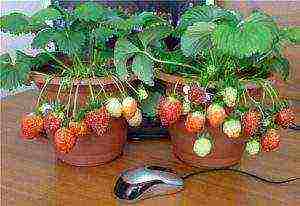Content [show]
The wild blueberry is becoming more and more popular and is grown commercially by farmers and in small quantities by gardeners to meet the needs of their own families. The fruits have a pleasant taste and aroma, as well as a large amount of useful substances. That's why growing blueberries from seeds at home - an interesting topic for all gardeners and hobbyists.

We suggest you learn how to grow blueberries from seeds at home
Features of growing blueberries and preparation for sowing seeds
The advantage of blueberries is that the plant is not whimsical and does not need special care. In the initial stages, it is worth deciding on a blueberry variety, preparing suitable conditions for the plant, fertilizing the soil, and choosing the right place for planting bushes.
The soil for planting shrubs should be fertilized with compost, peat, rotted foliage or sawdust. The root system reacts positively if, in addition to chernozem, there is a small amount of sand. The plant does not like intense watering or drought. It is necessary to ensure that the ground is always moderately moist. An excess of moisture will have a detrimental effect on the root system and yield.

Pictured are blueberry seeds
The ground under the bush should be acidic. Here is one simple way to determine its acidity. You need to take a small amount of soil from the site of the proposed planting of the plant and mix it with homemade vinegar. If the soil is acidic, then there will be no reaction, and if it is alkaline, you can observe a reaction in the form of hissing and foaming.
We recommend to know: The best varieties of blackberries: description, photos and characteristics.
A sunny area, protected from gusts of wind, located away from tall trees and buildings that create shade, is ideal for planting shrubs. Experienced farmers recommend planting multiple yielding varieties on the plot, such as early, medium and late. This will provide the whole family with enough berries for a long time.
What you need to know about growing blueberries from seeds at home?
Blueberry seeds are harvested from well-ripened berries. Dissolve the pulp with seeds in water, mix. Those seeds that have settled to the bottom are just suitable for sowing and must be collected, dried and sown. It is believed that the optimal sowing time is August.

The investment of time and effort pays off when the farmer begins to harvest a bountiful blueberry crop
If the gardener wants to sow in spring, the seeds must first be placed on wet sand for 3 months, and kept at a temperature of +5 degrees. This process is called stratification and is important in preparing seeds for germination. For sowing, containers with peat are prepared, seeds are sown on this surface and sprinkled with a thin layer of sand. A spray bottle is used for watering.
We recommend the article: The best varieties of currants with photos and descriptions.
The containers with the sown blueberry seeds are placed in a warm place and covered with foil to form a greenhouse. The soil should be sprayed regularly. The first shoots will appear in about a month. When the sprouts have several leaves, they can be transplanted into separate containers, which are placed in a warm and sunny place, and the plant is provided with regular watering.
Video about growing blueberries from seeds at home:
Of course, growing blueberries from seeds at home - business is quite laborious, but exciting. The investment of time and effort is more than compensated for in the summer, when the farmer begins to harvest a bountiful harvest of aromatic, tasty and healthy berries. Why not sow blueberry seeds on your plot ?!
(
estimates, average:
out of 5)
Blueberries are the closest relative of the well-known blueberries.... People previously believed that this berry caused a headache, and no one grew it. In the modern world, this opinion has been refuted, since its nutritional properties can give odds to popular berries.
 Varietal blueberry
Varietal blueberry
Benefit
Biologists from all over the world know the beneficial properties of blueberries. It contains a rich set of vitamins: B1, B2, PP, K and P, as well as the presence of ascorbic acid. Mineral salts of calcium, phosphorus, iron, sugar, pectins, fiber and much more.
All these elements have a positive effect on the human body:
- creates anti-inflammatory processes;
- acts as an anti-sclerotic and anti-sclerotic agent;
- activates choleretic and cardiotonic action.
In all biological manuals, experts talk about the amazing benefits of this berry.
Where to buy seeds or seedlings
You can buy blueberry seeds in any online store or on the market, the same is the case with seedlings. It is important to find varieties that are created with an eye to Russian conditions.
 Gavrish: Blueberry Forest Treasure
Gavrish: Blueberry Forest Treasure
Become familiar with the characteristics of the individual varieties and note the following characteristics:
- ripening period;
- the size of the berries;
- frost resistance (30-40 ° C)
Choosing the right seeds or seedlings will help you grow a berry-rich bush and delight your family with fresh fruits or great juice.
How to grow seeds
It is worth sowing fresh seeds at the end of summer, stratified seeds in spring. For sowing, take regular flower pots or boxes, which should be filled with high-moor peat. Place the seed not deeply and sprinkle with sand for 2-3 mm. Then pour a little water.

Having done all this, place the seedlings in a warm place with good lighting and cover with glass. Water and ventilate the future plant. After 2-3 weeks, when the first shoots appear, remove the glass and continue to water.
When 4-6 small leaves appear, transplant the plant into a greenhouse, where you should constantly monitor its growth, water and fertilize with a solution of mineral fertilizers.
How to grow a seedling
A good seedling from seeds appears in 1.5-2 years. Now you should transplant it from the greenhouse into a permanent habitat in the open air.

Blueberries require acidic and loose soil for their good growth and fertility. A hole is dug, slightly larger than the size of the root system, and the plant is transferred there. Add a mixture of peat and coniferous sawdust instead of soil, this will help give the soil the necessary acidity. Water well. After watering, sprinkle again with a mixture of peat and sawdust so that the moisture does not evaporate.
Expert opinion
Blueberries are not a capricious plant, but there are two important aspects to be followed closely. All you have to do is water the plant abundantly, especially in dry years, and monitor the acidity of the soil. You can add acidity to the soil using the same coniferous sawdust and peat. For the first time, the plants should be pruned for 3 or 4 years. Don't forget about mineral fertilizers.
By following these tips, you can grow an amazing plant that will provide you with berries for a whole year.
Blueberries, popular in Europe, are rapidly gaining demand in Russia, since the berries of this shrub turned out to be very useful for the human body. A significant content of vitamin C and many minerals, combined with a characteristic delicate taste, makes a healthy delicacy a dream for all summer residents. But, despite the variety of pleasant properties, farmers are in no hurry to grow shrubs on their plots.The reason for this is the lack of experience in planting and caring for blueberries. In reality, there is nothing complicated in this process, you just need to arm yourself with reliable information, the effectiveness of which has been tested in practice.
Blueberry berries
The best varieties of blueberries
Characteristics of tall blueberry varieties
Description
As mentioned above, blueberry is a shrub with dark gray bark and green shoots. The shrub is characterized by smooth and rather short leaves - no more than 3 centimeters. The flowers of blueberries are slightly larger, but still do not differ in colossal sizes - about 6 centimeters. As for the fruits, the berries of blueberries are very small - a little more than a centimeter. They are easily recognizable by their blue color and abundance of seeds. A characteristic feature of the fruit is a bluish bloom. The beginning of the flowering period of blueberries falls on May, and by the last month of summer the shrub begins to bear fruit.
Garden blueberry
Blueberry bush
Growing garden blueberries
Conditions
If we talk about industrial plant cultivation, then only acidic soils are suitable for this. Experts often use a litter of rotted leaves, which not only helps to improve the water regime so important for blueberries, but also significantly increases the fertility of the land.
Planting scheme of grown blueberry seedlings
Planting methods for blueberries in different types of soil
In order to create ideal conditions for the shrub in a personal garden plot, you will need:
- bark;
- sawdust;
- sour peat;
- foliage.
The main task of the farmer at this stage is to ensure that the acidity of the soil is between 3.7 and 4.8 pH units. Acetic acid or citric acid will help you achieve the desired result.
Tester
Important: Blueberries will grow well and yield generous yields only on soil that is moderately moist.
This means that areas located in lowlands and prone to waterlogging are immediately excluded. The plant is very afraid of high humidity, an excess of moisture in the soil leads to decay and death of the root system. As a result, the bush stops growing and no longer yields a crop.
We grow blueberries in sunny places
When choosing a place to plant blueberries, you need to find an area that will be sufficiently lit and well protected from the winds. If you plant a plant in partial shade, then you may not expect a rich harvest. Plus, the quality of the fruit will significantly decrease. Lack of light also leads to an increase in the growth time of the shoots, which means that by the first frost, they may simply die without having time to woody.
Experienced farmers argue that it is most advisable to plant not one, but several varieties of shrubs on their site. Thanks to such a cunning move, you can provide the plant not only with excellent pollination, but also count on a fairly generous harvest.
Seed preparation
If you decide to grow blueberries not with the help of seedlings, but with seeds, then you will have to be patient.
Traditionally, seeds are taken from those fruits that have already ripened well enough. They must be thoroughly kneaded with your hands until a soft mass is obtained, and then rinsed with water. Since there are a lot of seeds in blueberry fruits, many of them will remain at the bottom of the container - that's what we need.
Choosing the largest berries
The photo shows blueberry seeds
Blueberry seeds
At the next stage, the seeds need to be thoroughly dried - for this we put them on a special filter paper. In principle, after these manipulations, the seeds can be immediately used for sowing. If you do not plan to do this right away, they can be folded into a paper bag and stored for up to 10 years.
Blueberry Seed Growing Kit
Kit instructions
Seed stratification
Before sowing seeds, they need to be stratified, that is, prepared for germination. Despite the dreadful name, the procedure is quite easy, although not fast. Find moss or wet sand and place the seeds in it for about 90 days. The temperature should be between 3 and 5 degrees.
Seed stratification
Sowing
Sowing blueberry seeds involves knowing some of the nuances. For example, if you are going to use freshly harvested seeds, then you need to sow them in the last month of summer, but seeds that have been prone to stratification are sown in the spring. There are two main options for how you can sow plant seeds: in a pot or in a box. The most important thing is that the container is filled with peat.
Soil, peat
There is no need to be zealous and try to put the seeds deep into the substrate - there is no need for this. They should simply be scattered over the surface of the soil, and then sand should be poured on top (with a layer of up to 3 millimeters).
Filling a clean box with peat
Sow seeds and sprinkle on top with sawdust or sand
Instead of sand, you can use crushed sawdust, but then you need to increase the layer thickness to 50 millimeters. Plus, it will have to be watered.
After these procedures are over, it is worth covering the container with glass and placing it where there is a lot of light and enough heat.
Cover the box with a lid
The substrate with germinating seeds periodically needs to be not only watered, but also ventilated.
Do not be alarmed if you suddenly notice mold in the soil - you just need to treat it with fungicides.
The first sign that it is time to remove the glass is the appearance of the first shoots.
Blueberry seedlings
This usually happens 4 weeks after sowing the seeds. During this period, it is very important to provide the plant with proper watering. Now you have to wait until the first true full-fledged leaves appear on the seedlings. Only then can they be transplanted into containers.
Blueberry sprout
Blueberry seedlings
Grown seedlings
Alternatively, you can move the plant to a greenhouse, then the growing will be faster.
Top dressing
Not only the intensity of growth, but also the quality and quantity of the crop will depend on how correct feeding is provided to blueberries. Whichever place you choose for growing - a greenhouse or a greenhouse - seedlings need to be watered generously with water, as well as a special solution of mineral fertilizers.
To prepare the solution, you will need:
- fertilizer "Kemira" - 1 large spoon;
- water - 10 liters.
Kemira fertilizer
The components are thoroughly mixed, after which they can be used immediately. For one square meter of land, about a liter of top dressing is usually consumed. It is very important to wash off the solution from the leaves of the plant after the procedure. You need to feed blueberries from April to June - about once every 14 days.
Important: lime and manure are unsuitable fertilizers for growing blueberries, since they are poisonous to the plant, therefore, the shrub will simply die after such "feeding".
Transfer
In the spring, the material is removed, after which the seedlings are transplanted into the "school". This is their home for a fairly long period - here they will grow for about 2 years. And only after that you can transplant the shrub to the area in the garden or vegetable garden that you looked after for them. You can count on the harvest only after 2 years of waiting, but it is not worth drawing conclusions about the productivity of the grown plant yet. Only in the 7th year of the life of blueberries can one judge which seedlings are best suited for further cultivation of the shrub.
Blueberry care
Planting a shrub in a permanent place
If you have chosen undersized plant varieties, then the pits for planting must be placed at a distance of 80 centimeters from each other. If your choice fell on medium-sized or vigorous varieties, then the distance between the holes must be increased to 120 centimeters.
| Undersized | 80 centimeters |
| Medium, vigorous | 120 centimeters. |
The usual depth of a planting pit is about 50 centimeters and a diameter of 70 centimeters, however, when it comes to loamy soils, there are nuances. In particular, it is necessary to reduce the depth of the pit to 30 centimeters, but make it wider. Plus, the features of the soil require an additional drainage layer of about 15 centimeters. Alternatively, you can plant the plant on a ridge.
Planting blueberries
Planting garden blueberries in the ground
Mulching
An example of mulching with peat
In October, you need to start mulching the soil with peat, the layer of which should be about 7 centimeters. For greater fertility, the peat needs to be covered with spunbond - sometimes even 2 layers are used. Thus, gardeners prepare the plant for wintering.
Spunbond
Shelter for garden blueberries for the winter
Pruning
Garden blueberry pruning scheme
Once the blueberry is 6 years old, you need to think about pruning the plant. This procedure is carried out in the spring, when the earth has time to recover from the frost, but the buds have not yet blossomed. To rejuvenate the shrub, you first need to trim the crown, as well as remove all dry shoots and old, dead branches.
In addition to pruning, it is recommended to periodically loosen the soil. Thus, breathability is improved. However, this must also be done carefully, because the roots of the bush are not located too deep. Therefore, the depth of soil processing should not exceed 3 centimeters.
Video - Growing blueberries from seeds

Growing blueberry seedlings is much easier than messing around with seeds. However, if there are no seedlings, nothing else remains. You have to pay a lot of attention to them until the seedlings get stronger. To do this, you should familiarize yourself in more detail with the rules for growing blueberries from seeds at home.
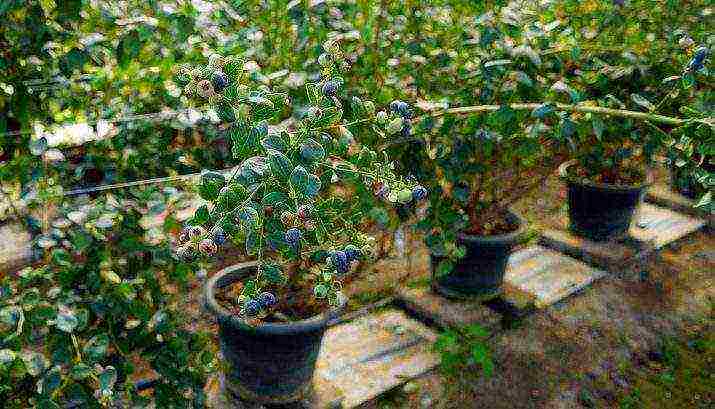 Features of culture
Features of culture
A distinctive feature of seed propagation of blueberries is the fact that the period from sowing to the first harvest can take several years. The berry belongs to the Heather family, for which wetlands are their natural habitat. Their pH level is extremely low.
The root system is practically hairless. It is extremely sensitive to fluctuations in soil moisture. Blueberries can coexist with mycorrhizal fungi, with which they share carbohydrates. In return, she gets a better assimilation of water and minerals. There are many varieties of blueberries. Some are relatively small in stature, others reach a height of more than 1.5-2 m.
Modern berry varieties that are usually planted on the site are hybrids. This is what determines successful cultivation. The root system is skeletal and overgrown. She begins to grow at a temperature of +7 degrees. Under particularly comfortable conditions (+17 degrees), it increases by 1 mm per day.

This culture has many useful qualities. Due to the content of antioxidants and a complex of vitamins, it has a beneficial effect on visual acuity, the work of the digestive tract, and reduces the manifestation of allergic reactions.
Unlike other plants, blueberries are unable to move water and nutrients horizontally from one side to the other. For this reason, it must be watered from all sides.
 What does the planting material look like?
What does the planting material look like?
The planting material is nothing more than small brown seeds. The seeds are oval or roundish in shape, depending on the variety. They are taken out exclusively from ripe and large berries, which are kneaded to a state of gruel. After that, they are washed, then dried and stored in a paper bag or immediately planted. The collected planting material can be used for 10 years.
Description of the breeding method
To grow blueberries from seeds, they must be stratified. By this word is meant a simple, though not quick procedure. For her you need moss or wet sand. Planting material is placed there for 3 months and kept at a temperature of 3-5 degrees above zero.
Blueberry seed propagation can be done in two ways. The time for sowing blueberry seeds is different and depends on the type of planting material. If these are just harvested seeds, they are planted in August, and those that have been stratified are sown in the spring.
 Outside
Outside
You can put the dried seeds in the refrigerator for the winter. At a constant temperature of 0 ... + 5 degrees, they will remain until spring. They are sown into the topsoil, deepening inward by 1-1.5 cm. In this case, it is imperative to mulch the soil with a mixture of peat, sawdust and leaves. The first shoots will appear in early May - early June.
Without feeding and watering, they can die. Sow them immediately to a permanent place.... Strongly germinated material cannot be used for seedlings.
Not every seed variety is able to adapt to spring soil, which should be warm at the time of planting. For this reason, blueberry seeds should not be planted in early spring.
 In room
In room
The seeds can be planted in a pot or box. The breeding method is simple: the seeds are scattered on the surface of the prepared soil. After that, sprinkle on top with a thin layer (up to 2 mm) of sand. If there is no sand, sawdust can be used. In this case, the thickness of the layer sprinkled on top will have to be increased by 2 mm. Both sawdust and sand must be moistened with a spray bottle and water at room temperature.
After that, the pot or box must be covered with transparent plastic wrap or glass and placed in a sunny place. It's good if it is warm. This will accelerate the germination of the planting material.
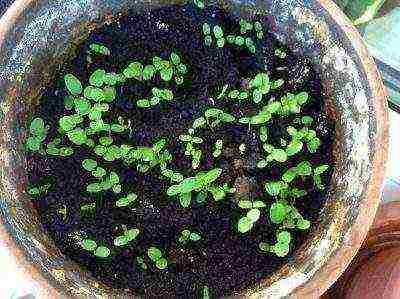
In order to prevent the death of the newly appeared sprouts, it is worth considering several important nuances:
- the substrate with germinating seeds should be watered and ventilated;
- if mold appears on the surface of the soil, it should be treated with a fungicide;
- glass or film is removed as soon as seedlings appear (after 2 - 4 weeks from the moment of sowing);
- transplantation is possible only when the first true leaves appear (these are 3 and 4 leaves after the first two);
- for growing, seedlings can be placed in a greenhouse. The bush can be transplanted to a permanent place (in open ground) 2 years after planting.
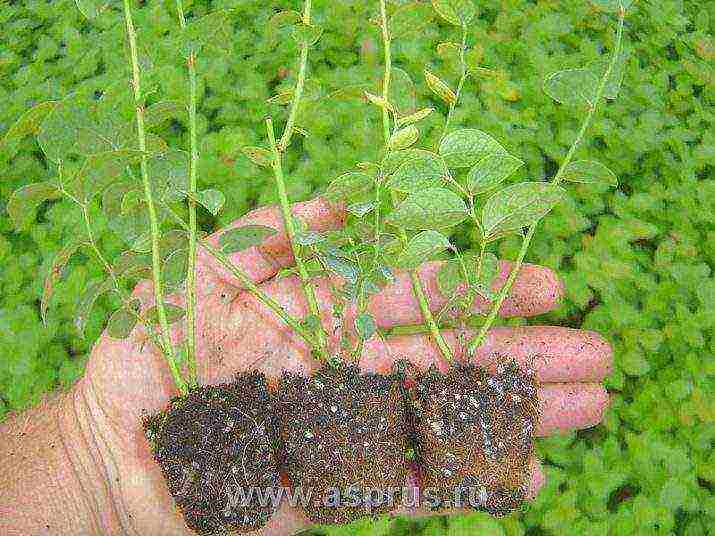
When using a peat tablet, it is poured with 50 ml of water at room temperature. After it has increased 5 times in height while maintaining its diameter, blueberry seeds with perlite are placed in it. After that, it is placed in a pot with soil prepared in advance, sprinkled with sand on top. Then they are placed on the lid of the pallet. Excess water will accumulate on the cover due to drainage.
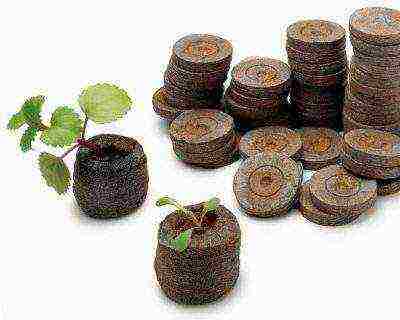 Which varieties are suitable?
Which varieties are suitable?
The breeding method for blueberries is suitable for garden varieties. It can be grown from the seeds of the following varieties:
- "Canadian Nectar" - tall blueberries with berries ripening in early August - mid September;
- "Blue Scattering" is a marsh grade with large berries that are distinguished by a sweet and sour taste;
- "Forest Treasure" - shrub culture with long-term fruiting;
- "Blue Crop" - tall blueberries up to 2 m high, resistant to diseases, frost-resistant;
- Earley Blue is a variety that ripens in early June;
- "Patriot" is a high-yielding and frost-resistant variety that ripens in the second half of July;
- "Elizabeth" is a late-fruiting berry, characterized by frost resistance and good taste.
Any of these varieties can be sown with seeds from ripe berries.
Soil preparation
Growing blueberries at home requires proper soil preparation. If the soil type on the site is close to swampy, the horizontal root system of blueberries is able to quickly take up space. The best soil for planting blueberries is a mixture of sand and peat. In order to mulch the soil, you can use:
- rotted sawdust;
- humus;
- needles.
Chips and branches of conifers are poured to the bottom. A mixture of peat with sand, rotted sawdust is added on top. You can add humus. Ash must not be used for soil preparation. It reduces the acidity required for proper growth and health of the bush. Comfrey infusion can be used to feed the soil.
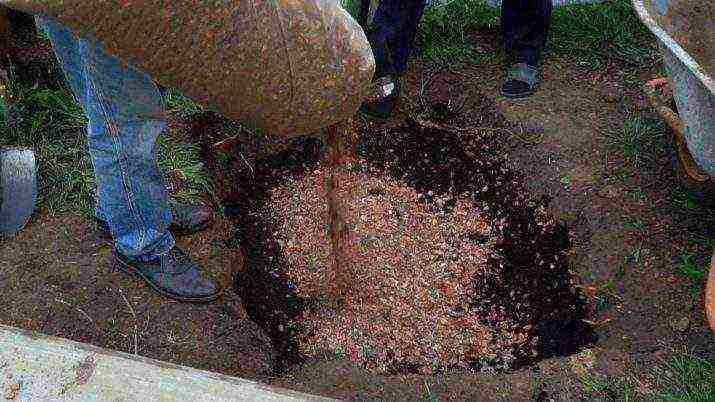 Germination
Germination
To ensure germination or to speed up the process of growing blueberries for seedlings, you can put the seeds on a damp cloth and keep them moist until germination. This method will allow blueberry seeds to germinate faster if planting time has been missed. Some gardeners keep seed bags in the refrigerator for stratification purposes.
In the spring, when it is necessary to plant them, the planting material is placed on the surface of the soil. Sometimes they are not sprinkled with sand at all. However, planting correctly means observing the technology. A greenhouse (an ordinary plastic bowl) is placed on the windowsill. Do not wait for shoots quickly. The maximum appearance period is about 1 month.
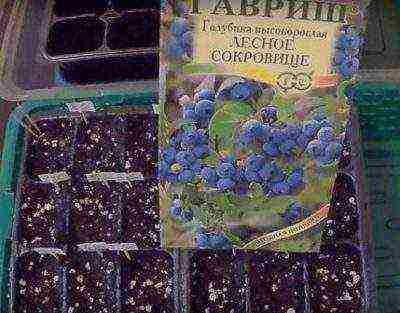 Agriculture
Agriculture
The conditions for growing blueberries include an open area, acidic soil, moderate soil moisture, proper pruning of the bush and planting according to all the rules. The size of the planting pit is approximately 60x60 cm. Before planting the seedling, it is taken out of the container, the peat lump is fluffed, and the bent roots are straightened. They are placed vertically in the landing pit.
Blueberries need weeding. However, this must be done very carefully. Working with a slipper in the near-trunk circles should be extremely careful. This can injure the root system.
Saplings are extremely sensitive to replanting. Until they take root, it is necessary to carefully monitor the water regime.
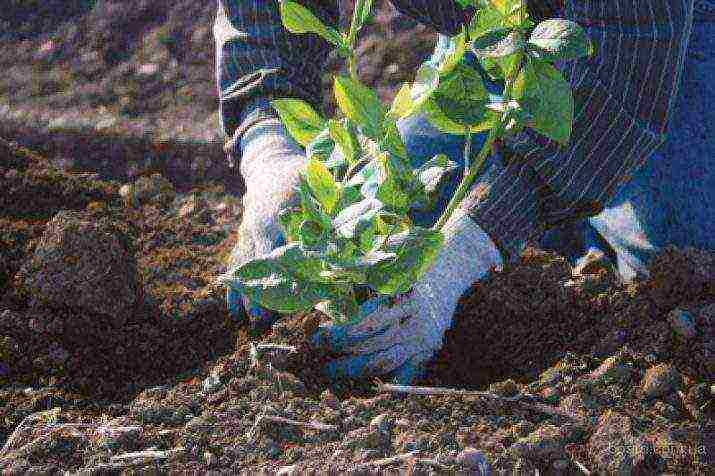
For this berry, you can use soil brought from a pine forest or swampy area. Planting pits can be spilled with a solution:
- citric acid (3 tsp per 10 liters of water);
- vinegar 9% (1 glass per 10 liters of water).
Blueberries love sunny places, otherwise the berries will be small and sour. In order to increase the yield, it is necessary to cut the bush. This should be done in late autumn, when the bushes will shed their leaves.
 Care
Care
Care for blueberry sprouts begins with the sowing of the seeds. While they are small, it is necessary to monitor the moisture content of the soil. There are other nuances:
- do not irrigate the soil with ice water;
- after planting in open ground, it is necessary to add nitrogenous fertilizers to the soil, but organic matter is excluded;
- row spacings should be located at a distance of 2 m;
- in the spring, sprinkle mulch with a layer of up to 10 cm using sawdust;
- the bush should be cut in early spring. In young bushes, small and diseased shoots should be removed;
- it is necessary to remove old shoots when the bush is 6 - 7 years old;
- green cuttings are carried out in July;
- to get large berries, you need to leave no more than 4 - 5 strong stems on the bush;
- you can fence the bushes so that the crowns do not touch the ground: this increases the yield;
- it is necessary to ensure that the bushes do not close; this is reflected in the taste of berries and yield;
- during the ripening period of berries, watering is a prerequisite for care.
How many years does it bear fruit?
To get the first crop in a garden plot or in a vegetable garden, at least 2 years must pass from the moment of planting. Sometimes you have to try the first berries later. The term depends on the type of soil, temperature regime, climatic features of the region, shade of the selected area. Sometimes gardeners note that the first berries can be removed from the bush after 4 years. The bush grows in different ways, which depends, among other things, on care and the sun, which blueberries love.
 Useful tips from gardeners
Useful tips from gardeners
So that the plant pleases the owners of the site for a long time with ripe and tasty berries, there are a few tips to take note of:
- The best and long-lasting fertilizer for the bush will be coniferous sawdust. You need to add them occasionally.
- You can not plant a bush where water is constantly in abundance. Moisture will cut off oxygen to the roots, and the plant will die.
- The main plant diseases are associated with the soil.If the acidity is neutral, the leaves turn pale. Digging, removing soil, adding peat and replanting will help to save the plant.
- Better to plant the plant in spring. Such plants are stronger, they are more adapted to the climatic conditions of the region.
- The berry does not like overheating of the soil. The land around the bush should be covered with sawdust or cranberries should be planted.
- It is necessary to monitor the acidity of the soil. The plant needs gray peat. It is a moss that has been melted for several years.
Growing seedlings
Planting of seedlings can be carried out throughout the growing season up to the first frost. In spring, this is possible when the soil warms up a little.
A seedling with an open root system can be planted in spring and autumn (October) to a depth of 6 - 8 cm. You cannot plant a plant in the lowlands. In heavy soil, the height of the hole should be smaller, while the diameter is larger.
When planting, you can use high-moor peat. It is mixed with earth in proportions of 1: 1. It will retain water and create the conditions necessary for its chemical composition. You can add "cubic rot" (the remains of rotten pine stumps of white color) to the planting hole. They will help the blueberry roots get the nutrients they need from the soil.
The type of soil matters, which differs in each region. If it is clayey, you will have to plant blueberries on raised ridges. If you do not do this, after rain on a flat surface, air will be blocked for the roots. Therefore, the plants will rot. Black soil damages roots when overheated. It should be hidden from the sun's rays.
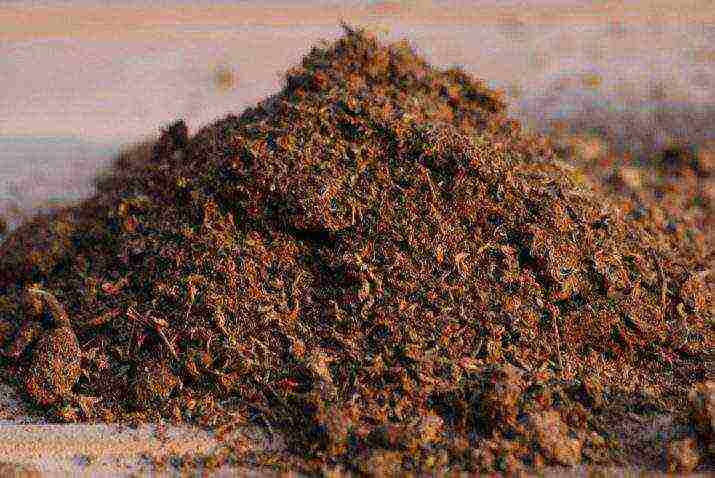
Some gardeners, when planting bushes in open ground in a permanent place, use film. It is covered at the bottom of the landing pit.
However, for optimal conditions, it is necessary to make perforations in it. If the ground is sandy above and clayey below, there is no need for a film.
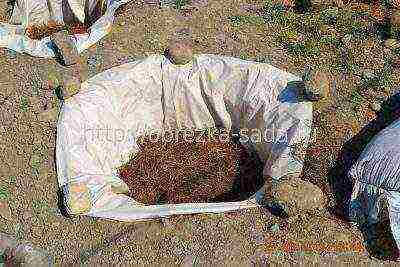 Reviews
Reviews
Planting blueberry seeds is considered controversial. The described blueberry breeding technology does not always give a 100% result. In some cases, it is not considered effective. Usually, seedlings appear well, but it is not always possible to create the desired level of moisture. Gardeners note that waterlogging and dry soil are the main reasons why sprouts die.
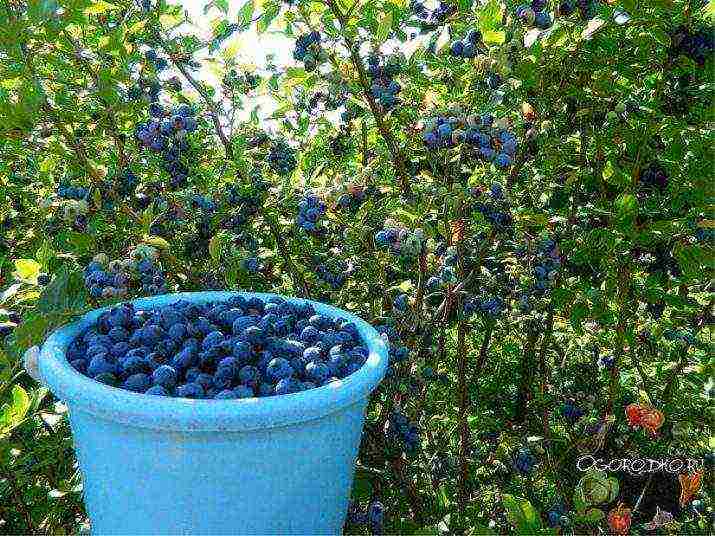
For information on how to grow blueberries from seeds at home, see the next video.


